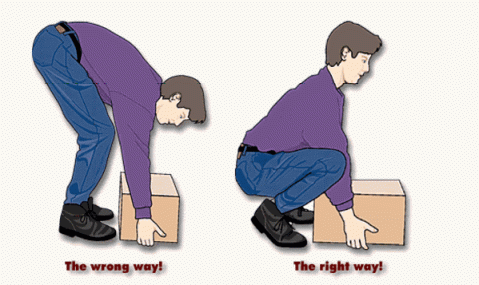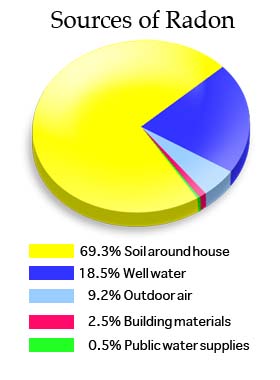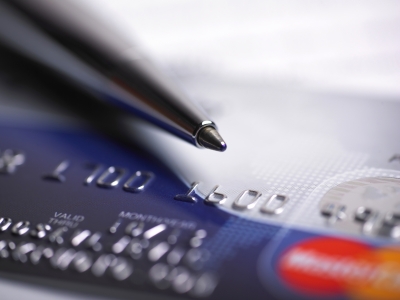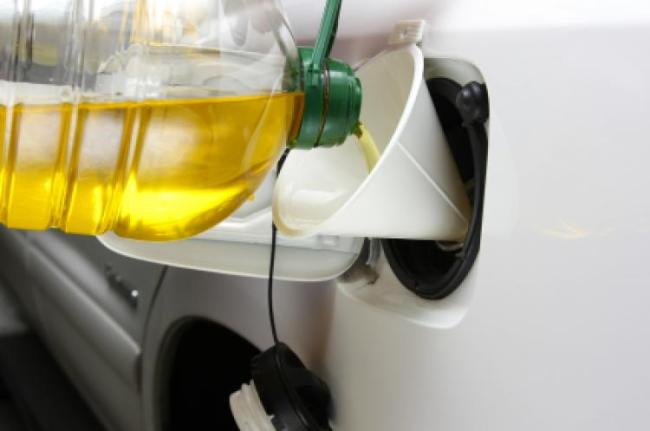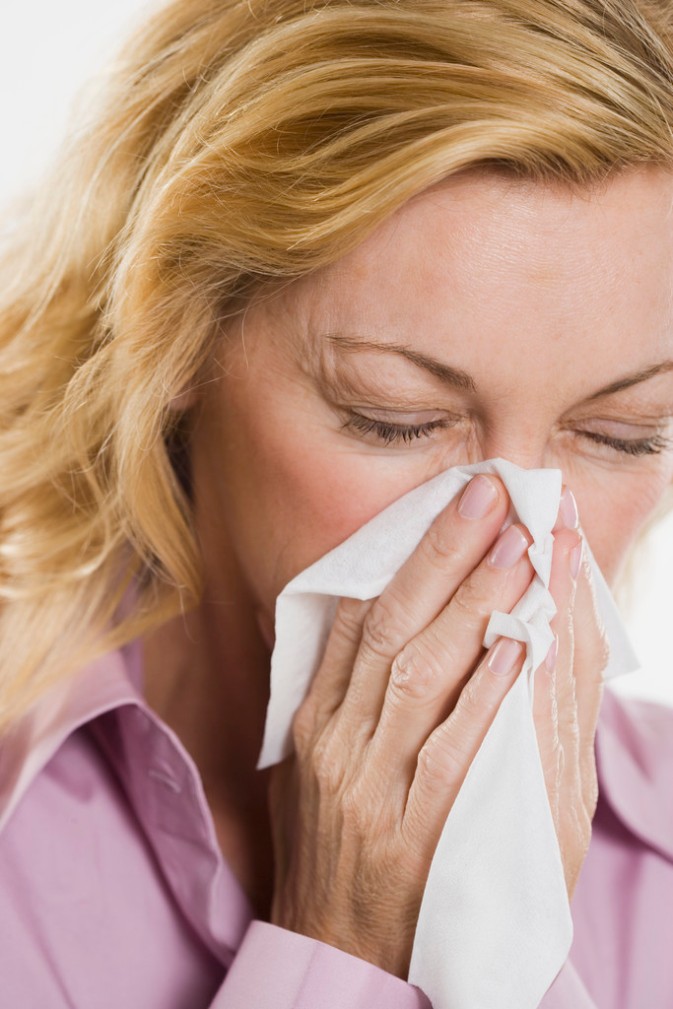Lift with Care to Limit Back Pain
Injuries caused by poor lifting and handling practices can cause major back pain. To avoid these unpleasant and often inhibiting injuries, remember these safe lifting and carrying recommendations while you are doing chores around the house.
Safe Lifting and Handling Techniques
Lifting from ground level:
- Get as close as possible to the load and bend down at your knees; not your back.
- Get a good grip on the object and test its weight.
- Keep the load close to your body and lift up with your legs.
- Be aware of your balance and what part of your body is doing the work – it should be your legs.
Lifting from a shelf, desk or counter:
- Pull the load close to your body and test its weight.
- Shift the weight of the load to your legs by keeping it close.
Lifting from overhead:
- Make certain you are standing on a stable surface before you attempt to lift.
- Test the load to be sure that you can lift it safely.
- Take the object off of the shelf carefully and maintain your balance.
- Maintain control of the load, and bring it down to waist level.
Carrying heavy loads around the house:
- Look ahead to make certain your path is clear.
- Avoid stairs if possible. If you must use the stairs, hold the banister or wall to maintain your balance.
- Have someone else hold doors and gates open for you.
- Change direction by moving your feet, not your hips.
- Keep your shoulders, hips and feet pointing in the same direction.
- Never twist at the waist while you are carrying something heavy.
- Always set the load down if it becomes too heavy to avoid straining a muscle.
Setting down heavy loads:
- Bend at your knees, not your waist and set down the corner of the object closest to you first.
- Remember to keep your fingers out from under the load as you set it down.
Safe lifting and carrying techniques can help you avoid strains, sprains and other painful injuries. Whatever the task at hand, make sure to ask for help from a family member when the load is too heavy for you to handle on your own!
For more information on avoiding back injuries and questions regarding your insurance, contact your agent.
Eliminate Radon Dangers in Your Home
Since you cannot see, smell or taste radon gas, it is not detectable in your home. So, why worry about radon? The National Cancer Institute reports that radon is the second-leading cause of lung cancer in the United States next to smoking.
The prevalence of radon is not isolated to one geographic area or type of home. In fact, one in every 15 homes has an elevated radon level, so it’s important for you to test and eliminate radon dangers at your residence.
What is Radon Gas?
Radon is a naturally-occurring radioactive gas produced by the breakdown of uranium in soil, rocks and water. Since the air pressure in a typical home is lower than the pressure in the soil around the foundation, the home acts like a vacuum and draws radon in through cracks in the foundation.
Radon may also be present in the water source and can be released into the air when water is used for general household purposes such as showering, or ingested when drinking. Testing for radon is the only way to determine if your indoor air quality and/or water are affected.
Testing for Radon
According to the EPA, radon gas levels can vary by day, season and geographic area. The radon levels can even be different in your home as compared to your next door neighbor’s home. Therefore, all potential homebuyers, current homeowners and home sellers should have their homes tested for radon.
The EPA recommends testing for radon under the following circumstances:
- The home was never tested.
- The home was tested more than two years prior.
- The home was renovated since it was last tested.
- You plan to occupy a lower level of the home than what was originally tested, such as the basement.
To test a home for radon, you can order a kit by mail from a qualified radon measurement service provider, purchase a radon kit from a local hardware store or hire a qualified radon tester (often also a home inspector).
If a radon test reveals that your home’s level is dangerous, you can install a radon mitigation system. A qualified radon reduction contractor can install a system in typically less than a day. If your home’s water source has high levels of radon, too, a point-of-entry treatment device can be installed to reduce emissions.
Ensure that your family is breathing easy by testing for radon and installing a radon mitigation system if the gas levels in your home are too high.
For more information on radon testing and your home insurance , contact your agent.
Seasonal Allergies: Spring
Mold growth blooms inside and outside with spring rains. As flowers, trees, weeds and grasses begin to blossom, allergies will follow.
Spring-cleaning activities can stir up dust mites, so be sure to:
- Wash your bedding every week in hot water to help keep pollen under control.
- Wash your hair before going to bed, since pollen can accumulate in your hair.
- Wear a mask and gloves when cleaning, vacuuming or painting to limit dust and chemical inhalation and skin exposure.
- Vacuum twice a week.
- Limit the number of throw rugs in your home to reduce dust and mold.
- Make sure the rugs you do have are washable.
- Change air conditioning and heating air filters often.
For more information on preventing spring allergies from taking over, contact your doctor. For more information regarding your insurance, contact your agent.
High Blood Pressure
Each time the heart beats, it pumps out blood into the arteries. Blood pressure is highest when the heart beats (called systolic pressure) and lowest when at rest (diastolic pressure). This is why blood pressure is always given as two numbers, such as 120/80, which is considered the normal range. Once the level reaches 140/90 or above, it is considered high blood pressure. With this condition, the heart and arteries work harder, and the chances of a stroke, heart attack or kidney problems are greater.
Causes and Risk Factors
No single specific cause has been identified in people with high blood pressure, but research is ongoing. In some people, it is the result of another medical problem or medication. When the cause is known, this is called secondary high blood pressure. Research has shown that the following factors put one more at risk for high blood pressure:
- Obesity
- Being African-American
- If male, being over age 45; if female, being over age 55
- A family history
- Having prehypertension (blood pressure in the 120-139/80-89 range)
- Excessive salt and/or alcohol consumption
- Not enough potassium in the diet
- Being physically inactive
- Having ongoing stress
- Smoking
- If female, taking certain oral contraceptives
Symptoms
Those with high blood pressure may have it for years without knowing, due to its lack of symptoms. The only way to find out is to have routine blood pressure checks during every visit to the doctor.
The Importance of Treatment
The first and best course of action when high blood pressure is discovered is to change eating and exercise habits. However, sometimes even when a person makes healthy changes, blood pressure remains high. In that case, a physician will most likely prescribe a blood pressure medication. If left untreated, high blood pressure can cause:
- Enlarging of the heart, which leads to heart failure
- Aneurysms in the arteries of the heart, brain, legs, intestines or spleen
- Narrowing of the blood vessels in the kidney, leading to kidney failure
- Hardening of the arteries, which can cause a heart attack, stroke or kidney failure
- Blood vessels bursting in the eyes
Prevention
High blood pressure can easily be prevented. Some of the best ways to avoid the condition include:
- Limiting salt, fats and alcohol
- Eating healthy foods such as fruits, vegetables, whole grains and low-fat dairy products
- Maintaining a healthy weight
- Being physically active
- Quitting smoking
Did You Know..?
Those with high blood pressure often exhibit few or no symptoms, which is why the condition is frequently referred to as the “silent killer.” For more information on controlling blood pressure, contact your physician. For more information regarding life insurance, contact your agent.
Food Safety Tips for Grilling
Grilling season is around the corner! When planning your next outdoor menu, one item you’ll definitely want to leave off the plate is foodborne illness—here’s how:
- Wash everything – Before and after cooking, wash all indoor and outdoor surfaces that will come into contact with food. Be especially careful to wash everything that comes into contact with raw meat or poultry and wash your hands often to prevent contamination.
- Marinate safely – If you plan on marinating raw meat, do so in a covered container in a refrigerator, not on the counter. This decreases the risk of bacteria.
- Keep everything covered – Cover all food with tin foil while outside. This keeps insects or bacteria from landing on and contaminating your food.
- Keep hot foods hot – Grilled food that is finished cooking can be kept hot until serving by moving it to the side of the grill rack. This keeps the food from overcooking and prevents bacteria from forming.
For more information on food safety tips for your health or questions regarding your life insurance, contact your agent.
Outdoor Exercise
Ready to move your exercise routine outdoors? As the temperature climbs, so does your risk of suffering from a heat-related illness. Review the list below to stay safe as the mercury rises:
- Stay hydrated by drinking plenty of water the day before, the day of, and after your workout.
- Avoid exercising between 10 a.m. and 4 p.m., the hottest period of the day.
- Wear a hat and sunglasses to reduce exposure to the sun.
- Be aware of the symptoms of a heat-related illness and take immediate precautions if you begin to feel faint, dizzy, nauseated, are sweating heavily, or experiencing a weak or rapid heartbeat.
DID YOU KNOW
Without taking the necessary precautions, exercising in high temperatures can lead to:
- Heat cramps
- Heat exhaustion
- Heatstroke
For more information on exercise tips, contact your physician. For more information regarding life insurance, contact your agent.
Managing Credit Card Debt
Your personal credit score is just as important as some of the other important numbers in your life…your blood pressure, your body mass index and your waist measurement. This number is based on personal credit management such as collection, length of credit history, types of credit cards used and applications for new credit. Financial institutions calculate your credit score, which determines what type of interest rate you will receive on a mortgage or credit card. Many other institutions are now using credit scores to calculate how high your health and auto insurance premiums will be as well.
Get Debt in Check!
Consumers who pay their balances on credit cards, pay mortgage payments on time and avoid late payments receive favorable credit ratings. This is important when considering how much you could pay in interest because you received a higher rate as a result of a low credit score.
Don’t despair. Even if your credit score is less than perfect, we’ve got some advice to get you back on track!
Tips for Those Who Want a Solid Credit Rating:
- Treat your credit cards like cash; deduct money from your checking account every time you make a purchase.
- Pay the entire balance of your credit card each month.
- Limit the usage of credits to two or three maximum and select cards with no annual fees, 25-day grace bill periods, rebate incentives or other incentives (airline miles, auto points, etc.) programs and single-cycle billing.
- Use your credit card with incentives for regular expenses such as groceries, utilities and gasoline.
- Conduct an assessment of your expenses quarterly and make adjustments to your spending if you are going over budget. Use a debit card only to curb spending.
Additional Tips for those who Need a Little Credit Boost:
- Enroll in a pre-paid credit card program in which you load money onto the credit card for purchases. Once you’ve reached your set limit, the card will not work.
- Establish a budget that includes a debt repayment plan monthly. As you pay off balances, call the creditor and ask them to close your account so that you are not tempted to use the card again.
Seek out financial assistance if you feel overwhelmed by debt. By reaching out to a financial advisor, you will be able to find specific ways in which you can minimize your debt and improve your personal financial situation. For more information on how this does affect your insurance, contact your agent.
Going Green When You Drive
Climbing gas prices and an increased focus on the effect fossil fuels have on the environment have drivers looking for ways to not only to keep costs down but also to protect the planet.
Drive Green
Vehicles that run on gasoline release greenhouse gases into the atmosphere. These gases contribute to climate change, air pollution and disease. To get better gas mileage and release cleaner emissions, drive a hybrid vehicle – these cars run on electricity, not just gas. Whether you get a hybrid or not, select a car that gets the best miles per gallon (MPG).
- Use vegetable-based biodiesel fuel in diesel cars and trucks.
- Use ethanol gas if your vehicle can use it.
- Buy an electric car or plug-in hybrid vehicle.
Change Your Driving Habits
The way you drive can affect your fuel economy.
- Avoid sudden starts and stops and drive the speed limit.
- Keep your engine speeds between 1,200 to 3,000 RPMs and up-shift between 2,000 to 2,500 RPMs.
- Do errands in one trip.
- Get directions to avoid getting lost.
- Turn off your car if you will be idling for more than a minute.
Keep Up On Maintenance
Make sure you get regular tune-ups on your vehicle, including oil changes and cleaning your air filter. Don’t forget these other maintenance suggestions:
- Check your tire pressure. Underinflated tires means the engine has to work harder, resulting in burning more fuel.
- Remove excess items in your vehicle – extra weight can have an effect on your fuel economy.
- Avoid using the air conditioner. Instead, open your windows, use an electric or solar fan, park in the shade or use a reflective windshield shade to keep your car cool.
Find Alternatives to Driving
- Carpool with coworkers and friends.
- Try a car-sharing program, such as FlexCar or ZipCar.
- Use public transportation, walk, rollerblade or bike to places you need to be.
- If possible, try altering your commute. Avoiding peak traffic times
can mean less gas is spent in stop and start traffic.
Did You Know?
Vehicles that get better gas mileage can save you hundreds of dollars every year. To find out how efficient your vehicle is compared to others, check out www.fueleconomy.gov.
For more information on going green when you drive, contact your auto insurance agent.
Relief During Allergy Season
|
Allergy symptoms such as sneezing and red, itchy, watery eyes are common during the spring and summer months when plants are budding and blossoming outside. To get some relief during allergy season, consider the following recommendations:
Contact your physician to learn more about the prescription and over-the-counter medications used to treat seasonal allergies. For more information regarding your insurance, contact your agent. |

